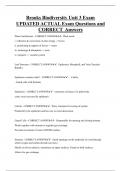Exam (elaborations)
Brooks Biodiversity Unit 3 Exam UPDATED ACTUAL Exam Questions and CORRECT Answers
- Course
- Institution
Brooks Biodiversity Unit 3 Exam UPDATED ACTUAL Exam Questions and CORRECT Answers Plants Architecture - CORRECT ANSWER- Plant needs i. collection & conversion of solar energy -> leaves ii. positioning & support of leaves -> stems iii. anchorage & absorption -> roots iv. transport ...
[Show more]



